| Examples of well prepared pans |
|
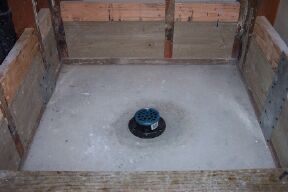 |
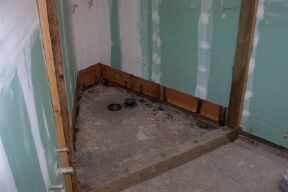 |
| 1. Here's an example of a well prepared pan.
In fact this particular customer went above and beyond the call of duty
by flashing over small gaps and adding a 2x4 on top of the 2x10 for extra backing. A 2x10 in between the studs is
sufficient backing--and is typically what I see in new construction homes. Gaps in the backing larger than 3 or 4 inches should be flashed. |
2.
Here's another remodel example where they put the green board on before I came in. This is not the best way to build
a shower stall! It is better for me to come in before the sheet rock so that it can be set and nailed
as close as possible to the top of the pan walls. This will ensure as little space as possible between
the pan and the sheet rock. Why is this important? To prevent any water from getting behind the pan.
If you put the sheet rock on before the pan is installed it must be at least 10 inches above the floor so
that I have enough room to work on the side walls. Any gaps between the top of the pan walls and the
sheet rock should be covered with construction paper (a black or brown 10 lb. paper infused with tar). Most tile
contractors will know to do this. If they don't, request it to be done. |
| |
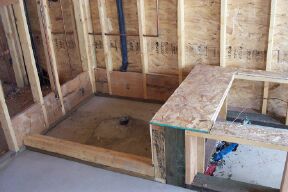 |
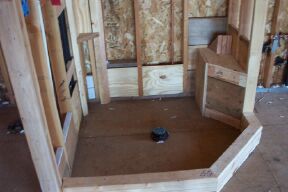 |
| 3. Here's a shower-tub combo.
Everything looks good, except one thing. There's no backing in the left, back corner of the
deck (right back corner of shower pan). This area can be a potential problem over time because it will be getting directly hit
with the water from the shower head. I added a 2x6
in between the stud for backing. Any time a tub deck runs into a shower like this treat it like a seat
with proper blocking. See the next image for an example. |
4. This pan only had one problem.
There was no backing in the back, left corner. I added a small piece of 3/8 plywood for backing. Also notice
how well he did the backing up and around the seat area. Nice job!
|
| |
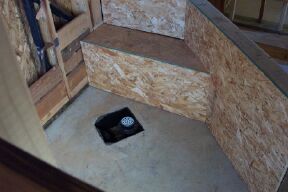 |
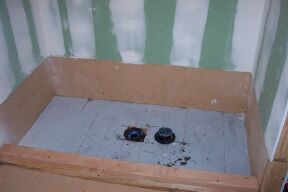 |
| 5. Notice the backing around
the seat area. Nice job! Here they used 2x6 in between the studs and 3/8 particle board on
the pony wall. However they didn't fill the hole with concrete--had to come back the next day. |
6. Here's another example where they used a 1/8 inch fiber board as backing.
I was surprised to see backing this thin, but it seemed to work. However I prefer 1/4 plywood or
blocking in between the studs. 1/8 inch fiber board may be too flexible to stand the test of time.
It's best to stick with what has been proven. Again, the sheet rock is nailed on before I came and
is a little high. |











